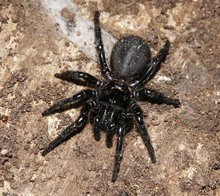Article: Information on Australian funnel-web spider

Sydney funnel-web spider
 The Australian funnel-web spiders are very dangerous spiders of the family Hexathelidae. This family consists of two genera: Hadronyche (which has the higher mortality rate) and Atrax (which has probably caused more bites). They are notorious for the inclusion of the Sydney funnel-web spider (Atrax robustus) native to eastern Australia.
The Australian funnel-web spiders are very dangerous spiders of the family Hexathelidae. This family consists of two genera: Hadronyche (which has the higher mortality rate) and Atrax (which has probably caused more bites). They are notorious for the inclusion of the Sydney funnel-web spider (Atrax robustus) native to eastern Australia.
This spider is probably one of the three most dangerous spiders in the world and is regarded by some to be the most dangerous. It has a powerful neurotoxin that is known to cause death within a period ranging from 15 minutes to three days. Although extremely toxic to primates, the venom appears to be fairly harmless to many other mammals, including cats and dogs which neutralise the venom totally within 30 minutes. While some very venomous spiders may give dry bites, these spiders do so much less frequently.
The venom, for some reason not easily apparent, is more toxic in the male. The female venom was thought to be only about a sixth as potent to humans as that of the male but recent reseach has proven that false. The bite of a female or juvenile may be serious; however, considerable variability occurs in venom toxicity between species.
Examination of bite records seems to indicate that wandering males have caused a large majority of fatal bites to humans. Most bites seem to occur when the male spiders wander about looking for receptive female of their kind for mating during the warmer months of the year.
Males, recognised by the modified terminal segment of the palp, are aggressive and tend to wander in search of females at night in summer rain. They are attracted to water and hence are often found in swimming pools where they have fallen while so engaged. They also show up in garages and yards in suburban Sydney.
There have been 26 recorded deaths in Australia in the last 100 years from spider bites, 13 of these potentially from male venomous funnel-web spiders. Most victims will have been the young, ill and infirm before antivenom was developed in 1981 through a passionate team effort led by Dr Struan Keith Sutherland (17 June 1936 - 11 Jan 2002), head of immunology at the Australian Commonwealth Serum Laboratories in Sydney. Fortunately, the antivenom is fast-acting and highly and globally effective. There have been no deaths since it became available.
90% of bites to humans from this spider are judged not serious enough to warrant administration of antivenom. However, the remaining 10% of the bites demonstrate the importance of promptly securing medical advice in case emergency treatment should prove necessary.
These spiders construct a funnel shaped web and lurk for prey in the small end of the funnel. They frequently search for a place to nest under human dwellings, or under nearby rocks, logs, or other similar objects. They are most active at night. They are large, the largest being about 5 cm long, and they often bite aggressively and repeatedly. It is said that these spiders are unable to climb well because of their bodyweight. However they can move quickly across the ground.
Although they are rather small compared to the true tarantulas, they should not be handled without taking substantial precautions because their fangs have been known to penetrate fingernails and soft shoes, resulting in dangerous bites.
Like the related diplurid spiders, the hexathelids have generally long spinnerets. Members of the genus Hadronyche may also cause fatal envomations although none have been recorded. Most hexathelids are found in Australia, New Zealand and Asia. One species is known for the Mediterranean region and two from South America.
Do you like it?
Source: Wikipedia

Copyright © 2002-2025 Ondrej Rehak. All rights reserved.

Visit: tarantulas
| scorpions
| tarantulas
| camel spiders
| scolopendra
Recommended: beetles | entomology | insect | beetle pics | Bolivia
Recommended: beetles | entomology | insect | beetle pics | Bolivia